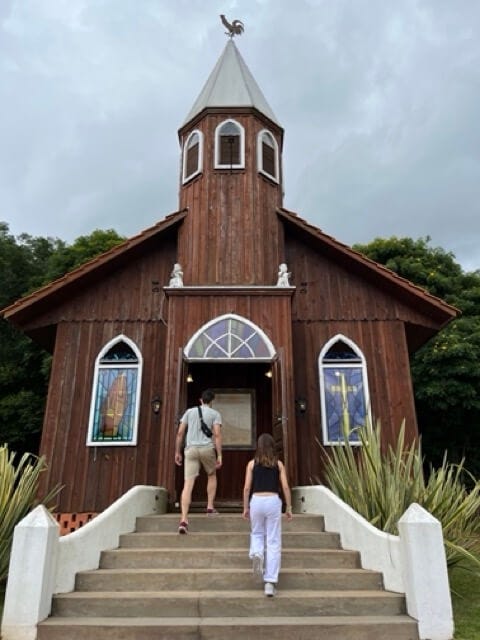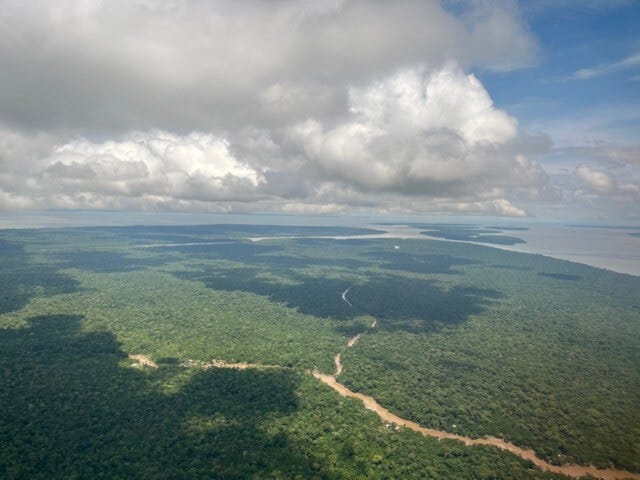TravelVince News #20
O que faço aqui? | What am I doing here?
For English, please scroll down to the British flag and Italic text. Thanks! If you haven't subscribed yet, please do so down here:
🇧🇷 Hoje chego à sua caixa postal direto de Belém, capital do estado do Pará, a apenas 2 graus abaixo do Equador. Por aqui tudo é enorme. Os rios, as florestas, as ilhas, os peixes e até as mangueiras que dão sombra às avenidas. Belém foi imponente na época da colonização e teve um boom econômico com a extração da borracha nos idos de 1870. Os barões chegaram a construir um teatro à imagem do Scala, de Milão, e mandavam as roupas para lavar em Paris. Mas um dia tudo isso acabou e ficaram apenas traços desta história, no teatro, em algumas casas bonitas, na catedral.
Enquanto chove (muito) lá fora, sento e escrevo sobre as viagens que planejo para 2023. Serão viagens a lugares inusitados. Belém, por exemplo. Na semana passada estive em Carambeí e Witmarsum, a poucas horas de Curitiba, mas quase na Holanda. Até moinhos eu vi. Perto e longe, quero olhar para esses lugares pelos quais passamos despercebidos, ou que não vêm em mente ao planejarmos férias.
Assim que a chuva parar, embarco para o Suriname, outro lugar exótico e quase apagado da cabeça de todos. Apesar de fazer fronteira com o Brasil, pouca gente ouviu falar de Paramaribo. Mas reconheço que não tem muito o que fazer por lá, a não ser que você seja um turista holandês aproveitando as tarifas de baixa temporada da KLM para tomar sol e ver a Amazônia. O Suriname foi colônia holandesa à força. Carambeí é colônia holandesa por opção. Belém não tem nada a ver com a Holanda, mas durante a invasão holandesa do Nordeste por Maurício de Nassau (1630-1654), o povo daqui se mobilizou.
O Brasil nunca deixa de me surpreender com sua diversidade. Fui tomar um sorvete na famosa sorveteria Cairu, na Estação das Docas, e demorei para escolher entre uxi, mangaba, carimbó, muruci, taperebá e bacuri. No buffet do Manjar das Garças os pratos eram muçuã de boitequim, maniçoba, pirarucu com jambu e arroz paraense com tucupi. Me senti na festa de casamento da Iracema.
Fui a uma exposição chamada Diversidade Amazônica, no Museu Emílio Goeldi e descobri que há 5 teorias de como os humanos chegaram às Américas. Na escola aprendi apenas a do Estreito de Bering. Num mapa interativo, dava para ver a diversidade linguística dos povos originários e alguns pontos em comum entre os tupinambás, tapuias e carijós. Isso sem falar dos peixes de escamas e peixes de couro que povoam os rios da bacia amazônica. Em Curitiba só tem tilápia, lambari e robalo!
Já tenho em mente alguns outros destinos, mas que vou revelando ao longo do ano nesta newsletter. Em fevereiro já fica combinado que vou contar sobre a Guiana Holandesa, ou melhor, Suriname. Hoje paro por aqui, junto com a chuva com hora marcada de Belém.
🇬🇧Today I land at your mailbox directly from Belém, capital of the state of Pará, just 2 degrees south of the Equator. Here everything is huge. The rivers, the forests, the islands, the fish and even the mango trees that shade the avenues. Belém was imposing during the colonization and had an economic boom with the extraction of rubber in the 1870s. The barons even built a theater just like the Scala, in Milan, and sent their clothes to be washed in Paris. But one day it all ended and only traces of that history remain, in the theater, in some beautiful houses, in the cathedral.
While it rains (a lot) outside, I sit and write about the trips I plan for 2023. They will be trips to unusual places. Belém, for example. Last week I was in Carambeí and Witmarsum, a few hours from Curitiba, but almost in Holland. I even saw windmills. Near and far, I want to look at those places we pass by unnoticed, or that don't come to mind when planning a vacation.
As soon as the rain stops, I'm off to Suriname, another exotic place that's almost out of everyone's mind. Despite bordering Brazil, very few people have heard of Paramaribo. But admittedly, there isn't much to do there, unless you're a Dutch tourist taking advantage of KLM's low season rates to sunbathe and see the Amazon. Suriname was a Dutch colony by force. Carambeí is a Dutch colony by choice. Belém has nothing to do with Holland, but during the Dutch invasion of Brazil by Maurício de Nassau (1630-1654), the population here mobilized against it.
Brazil never ceases to amaze me with its diversity. I went for an ice cream at the famous Cairu ice cream shop, in Estação das Docas, and it took me a while to choose between uxi, mangaba, carimbó, muruci, taperebá and bacuri. At the Manjar das Garças buffet, the dishes were muçuã de boitequim, maniçoba, pirarucu with jambu and rice from Pará with tucupi. It felt like a wedding party at a local tribe. I should have worn my feathers.
I went to an exhibition called Amazonian Diversity, at the Emílio Goeldi Museum and I discovered that there are 5 theories of how humans arrived in the Americas. In school I only learned about the path via the Bering Strait. On an interactive map, it was possible to see the linguistic diversity of the original peoples and some points in common between the Tupinambás, Tapuias and Carijós. Not to mention the fish with scales and fish with leather that populate the rivers of the Amazon basin. In Curitiba, there is only tilapia, salmon and sea bass!
I already have some other destinations in mind, but I will reveal them throughout the year in this newsletter. In February it is already agreed that I will tell you about Dutch Guiana, or rather Suriname. Today I stop here, along with the scheduled rains of Belém.











Seja aqui… ou lá, sempre amando!!!!!!